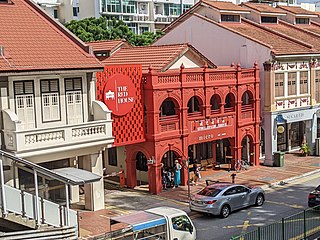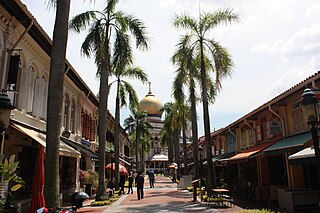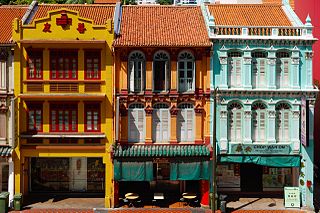
Katong is a residential neighbourhood in the eastern portion of the Central Region of Singapore, within the Marine Parade planning area. The Katong district stretches from Fort Road area to the Joo Chiat area. It used to be located by the sea, before land reclamation towards the south to East Coast Park was created for housing and recreational purposes beginning in the 1960s to 1970s.

Geylang is a planning area and township located on the eastern fringe of the Central Region of Singapore, bordering Hougang and Toa Payoh in the north, Marine Parade in the south, Bedok in the east, and Kallang in the west.

Marine Parade is a planning area and residential estate located on the eastern fringe of the Central Region of Singapore. Straddling the tip of the southeastern coast of Pulau Ujong, Marine Parade serves as a buffer between the Central and East regions of the country. Bordering it are the planning areas of Geylang to the north, Kallang to the northwest, Bedok to the northeast, Marina East to the southwest and the Singapore Straits to the south.

Tanjong Pagar is a historic district located within the Central Business District of Singapore, straddling the Outram Planning Area and the Downtown Core under the Urban Redevelopment Authority's urban planning zones. The district has a rich history and is known for its cultural and architectural landmarks, making it a popular tourist destination.

Kampong Glam is a neighbourhood and ethnic enclave in Singapore. It is located north of the Singapore River, in the planning area of Rochor, known as the Malay-Muslim quarter.
The Bedok Police Division is one of the seven land division of the Singapore Police Force. Bedok Division covers approximately 114 square kilometres of the eastern sector of Singapore. The building became operational on 1 August 1987 when the former Joo Chiat Police Station at East Coast Road was closed down.

Boat Quay is a historical quay in Singapore which is situated upstream from the mouth of the Singapore River on its southern bank. It spans from the shophouses near UOB Plaza, stretching along one bank of the Singapore River, all the way till Elgin Bridge.

Geylang Road is a major trunk road linking Singapore's eastern suburban areas with the country's central business district. Deriving its name from the area of Geylang where the road cuts through, it is fronted on both sides by low-rise shophouses protected statutorily from urban redevelopment in keeping with its history and urban heritage.

Jumbo Seafood is a Singaporean restaurant chain specialising in the seafood aspects of Singaporean cuisine and dishes, such as Chili crab. First opened in 1987 with an outlet at the East Coast Seafood Centre modeling and taking design elements similar to the non affiliated JUMBO Floating Restaurant Hong Kong, Jumbo Kingdom. It became a hit, it then opened an additional five outlets throughout the country including in the suburban areas of Serangoon Gardens as well as the Singapore Indoor Stadium. As of 2022, it has 5 outlets in Singapore.

Gedung Kuning is a Malay historical residence in Singapore. Located at 73 Sultan Gate, Gedung Kuning stands just outside the Malay Heritage Centre, near Masjid Sultan in the historic district of Kampong Glam in Singapore. However, from 1919 to 1925, the Gedung Kuning's address was 33 Sultan Gate. Once forming an annexe to the adjacent palace of Singapore's Malay rulers, Istana Kampong Glam, it became the private residence of Haji Yusoff, a prominent Malayo-Javanese merchant and four generations of his family. Together with the Istana, the compound was refurbished as part of the development of the Malay Heritage Centre in 2004.

Balestier is a sub zone located in the planning area of Novena in the Central Region of Singapore. The main road, Balestier Road, links Thomson Road to Serangoon Road and the road continues on as Lavender Street. The area is home to rows of shophouses, such as the Sim Kwong Ho shophouses, the Balestier Art Deco shophouses, 412-418 Balestier Road, and 601-639 Balestier Road, low-rise apartments and commercial buildings as well as a shopping mall known as Shaw Plaza. Balestier also has another mall, Zhongshan Mall. There are several lighting and electrical shops along Balestier Road, which is also home to the Ceylon Sports Club and the Indian Association. The area is known for its food such as bak kut teh and chicken rice. In the area, there are several apartments, condominiums, and budget hotels.

i12 Katong is a seven-storey shopping mall in the east of Singapore. It is located in the heart of Katong at the junction of East Coast Road and Joo Chiat Road. The mall was closed for renovations in March 2020 and had its soft reopening on 23 December 2021, and its grand reopening on 23 June 2022.

Kampung Cina, is a Chinatown located in Kuala Terengganu, Terengganu, Malaysia. Kampung Cina is located along Jalan Bandar, in Kuala Terengganu city centre at the river mouth of Terengganu River that empties into the South China Sea. Kampung Cina literally means Chinese Village; it is also called Tn̂g-lâng-pho (唐人坡) or KT's Chinatown by local people. It is one of Southeast Asia's early Chinese settlements and contains stately ancestral homes, temples, townhouses, and business establishments. The town is small but has colourful shophouses along both sides of the road that carries traditional flavour.

Sino-Portuguese architecture, also known as Chinese Baroque,Straits/Singapore Eclectic architecture or Peranakan architecture is an Asian hybrid style incorporating elements of both Chinese and Portuguese architectural styles. It is common in urban centers where Chinese settlers lived in southern China and the Peranakans of the Malay Peninsula, with examples found and most prominently conserved and maintained in Singapore.

Peranakan Place, formerly known as Peranakan Corner, is a row of six two-storey shophouses facing Orchard Road, built around 1902 at the intersection of Emerald Hill Road and Orchard Road in the planning area of Newton in Singapore. It forms part of the Emerald Hill Conservation Area within the Orchard district in central Singapore.

Katong Park is neighborhood park located in Katong, Singapore at the junction of Meyer Road and Fort Road. Built in the 1930s above the buried remains of Fort Tanjong Katong, it was one of Singapore’s oldest parks with the first public bathing pagar and was highly popular with families during the weekends. After the coastal reclamation works in the 1970s, the park lost its sea frontage and declined greatly in popularity. It now remains as a small community park serving nearby residents.
Violet Oon is a Singaporean chef, restaurateur, and food writer known for her food columns, cookbooks, and restaurants specializing in Peranakan cuisine. She has been the food ambassador of Singapore since 1988.

Tanjong Katong Complex is a shopping complex in Geylang Serai, Singapore. Completed in 1982, the complex was the first air-conditioned shopping complex built by the Housing and Development Board and has since become known for servicing the Malay community in the area.

The Chin Mee ChinConfectionery is a historic kopitiam in Katong, Singapore. Located at 204 East Coast Road, Chin Mee Chin started out as bread delivery business in the 1920s by Hainanese native Tan Hui Dong before becoming a kopitiam in 1925 by renting 204 East Coast Road. The business would be taken over by Hui Dong's son Tan Joo Long in 1947 following his father's death in Sook Ching. The younger Tan expanded the business by serving other foodstuff and fully purchasing the building as well as giving the name 'Chin Mee Chin'. Following a surge of Eurasians living in the Joo Chiat area during the 1970's, Chin Mee Chin decided to appeal to the Eurasians by serving Eurasian confectionary, which would later become staples on their menu. In 2021, Food and beverages company Ebb & Flow acquired Chin Mee Chin and revived it after it was closed down in 2018 due to a lack of manpower and succession.

















